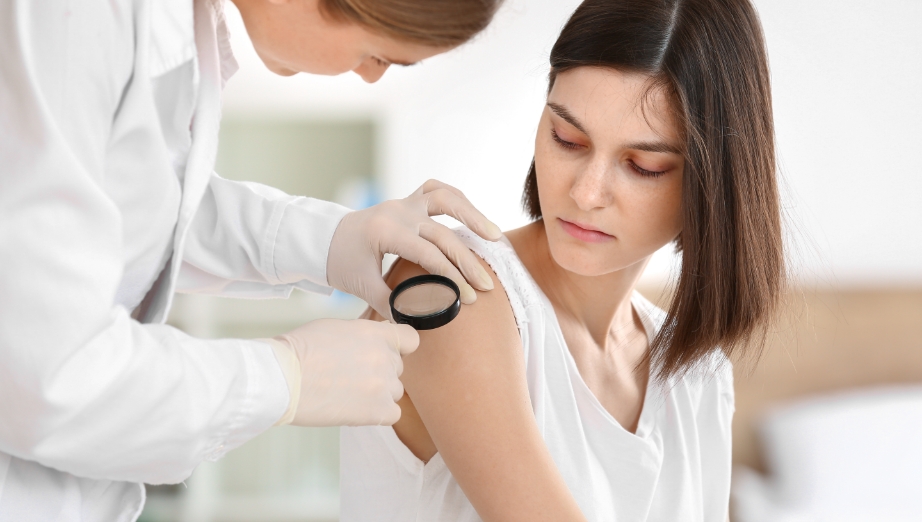Basal Cell Carcinoma
Basal cell carcinoma (BCC)is the most common form of skin cancer in Australia. It typically develops on sun-exposed areas of the skin, presenting as abnormal growths or lesions with characteristics such as a pearly or waxy appearance, raised edges, and sometimes bleeding or crusting.
1. Symptoms and signs of Basal Cell Carcinoma: BCC can present in several ways. Awareness of these features can help individuals seek timely professional review.
- Skin Lesions: One of the hallmark signs of basal cell carcinoma is the development of skin lesions. These lesions may appear as pearly or waxy bumps on the skin, often with visible blood vessels or a depressed centre. They may also present as flat, flesh-coloured, or brown patches that resemble scars.
- Abnormal Growths: Basal cell carcinoma can give rise to abnormal growths on the skin, which may exhibit irregular borders and an uneven surface texture. These growths may gradually increase in size over time and can vary in colour, ranging from pink and red to brown and black.
- Non-Healing Sores: Another common sign of basal cell carcinoma is the presence of non-healing sores or ulcers on the skin that persist for an extended period. These sores may crust, bleed, or ooze, and they may not heal with conventional wound care measures. If a wound or sore has not healed within 6 weeks, it’s best to have it checked.

2. Causes and Risk Factors of Basal Cell Carcinoma: The development of basal cell carcinoma (BCC) is primarily associated with a combination of environmental exposures, genetic predispositions, and individual lifestyle factors. By investigating the underlying reasons and recognising significant risk factors related to basal cell carcinoma, individuals can take steps to manage their risk of developing this prevalent skin cancer.
- Sun Exposure and UV Radiation: Prolonged and unprotected exposure to ultraviolet (UV) radiation from the sun is the leading cause of basal cell carcinoma. UV rays can damage the DNA in skin cells, which may lead to the development of abnormal growths. Individuals with a history of frequent sun exposure, especially those who work or spend significant time outdoors, are at an increased risk. Protecting the skin from UV radiation through the consistent use of sunscreen, wearing protective clothing, and seeking shade during peak sun hours are important steps in managing sun-related skin damage and lowering the likelihood of developing basal cell carcinoma.
- Genetic Predispositions: Genetic factors also play a role in the development of basal cell carcinoma. Individuals with a family history of skin cancer, including basal cell carcinoma, may be more likely to develop the condition themselves. Certain inherited genetic syndromes, such as Gorlin syndrome (nevoid basal cell carcinoma syndrome), can predispose individuals to multiple basal cell carcinomas at a young age. Individuals can increase their awareness by understanding their family history and taking measures to monitor their skin’s health.
- Immune Suppression: Immune suppression, whether due to medical conditions such as HIV/AIDS, an organ transplant, or as a result of immunosuppressive medications, can increase the risk of basal cell carcinoma. A less active immune system may be less effective at identifying and managing abnormal cells. Individuals who are immunocompromised should be particularly vigilant about sun protection and undergo regular skin examinations to allow for the early detection of any skin changes.
3. Decreasing Risk of basal cell skin cancer: While certain risk factors for basal cell carcinoma, such as genetic predispositions, cannot be changed, individuals can take proactive steps to minimise their risk. Sun protection practices, including wearing broad-spectrum sunscreen, protective clothing, and sunglasses, and seeking shade during peak sun hours, are important considerations in managing UV exposure and its effects on the skin. Individuals should avoid indoor tanning beds, as they emit harmful UV radiation that can increase the risk of skin cancer. These are now illegal in Australia in a commercial setting. Regular skin self-examinations and annual skin cancer screenings with Dr Barney Gordon can assist in the early detection of skin changes, which allows for a timely discussion of management options.
By understanding the underlying causes and identifying key risk factors associated with basal cell carcinoma, individuals can take proactive measures to support their skin health.
Incorporating sun protection practices into daily routines and seeking regular skin cancer screenings are crucial steps in managing the risk of basal cell carcinoma and promoting overall skin wellness.
4. Management Options for Basal Cell Carcinoma:
Management options are individualised based on the characteristics and location of the lesion. These approaches are discussed during a consultation with Dr Barney Gordon following clinical examination and, where necessary, biopsy confirmation.
- Surgical Excision: A local anaesthetic is used while the lesion and a margin of surrounding tissue are removed. The specimen is sent for pathology review.
- Cryotherapy: This approach involves applying liquid nitrogen to the lesion. The area may temporarily blister, crust, or leave a pale mark after healing.
- Light-Activated Skin Therapy Consultations (PDT): This in clinic option involves applying a photosensitising agent to the skin and dressings for several hours, then removed from the skin and then activated with a specific wavelength of light. The consultation will cover how this approach can address larger areas and what the cosmetic considerations are.
- Mohs Surgery: This is a specialised procedure where tissue is removed and examined microscopically layer by layer during the procedure. It’s often discussed for lesions in cosmetically sensitive areas or those with particular growth patterns. We may discuss whether a referral to a specialist service is a suitable step for you.
- Radiation Therapy: This pathway uses high-energy radiation beams. It may be discussed as an option for lesions in areas less suitable for surgery. . The consultation would cover how this therapy is administered.
- Topical Cream Consultations:Certain superficial BCCs may be managed with prescription-only topical creams (such as Imiquimod or Fluorouracil), which are applied over several weeks under medical supervision. These creams interact with the skin’s local immune response over several weeks. We will discuss the application process, the expected skin reactions (like redness or irritation), and the typical duration of use.
- Discussion and Planning:Each management pathway has benefits, limitations, and possible side effects, which are discussed during consultation. The decision depends on individual lesion characteristics, patient preference, and clinical suitability..
Understanding the considerations associated with each management option is essential for making an informed decision. A thorough evaluation with a Specialised GP with additional training in skin cancer such as Dr Barney Gordon is the first step.
5. Prognosis and Outlook for Basal Cell Skin Cancer:The development of basal cell carcinoma (BCC) is associated with environmental exposures, genetic predispositions, and individual lifestyle factors
Recurrence Risk: The outlook for basal cell carcinoma is generally favourable, particularly when it is identified and managed early.
However, recurrence can occur, particularly for individuals with a history of multiple basal cell carcinomas or certain subtypes.
Factors that may influence recurrence include the characteristics of the initial lesion, its size, and the involvement of deeper or complex structures.
Regular skin examinations and follow-up appointments support early detection of any new or recurrent lesions.
Metastasis Likelihood: Unlike other forms of skin cancer, such as melanoma, basal cell carcinoma rarely spreads to other parts of the body.
- The likelihood of metastasis is very low, with most basal cell carcinomas remaining localised to the skin.
- In the uncommon cases where spread occurs, it typically involves nearby lymph nodes or structures.
- Maintaining regular reviews allows early identification and management of any changes.
Long-Term Outlook: When managed in its early stages, basal cell carcinoma is generally associated with good outcomes.
- The most suitable management pathway is determined after thorough clinical assessment.
- Ongoing sun protection practices, consistent self-monitoring, and professional skin examinations remain important for maintaining long-term skin health.
- Regular communication with Dr Barney Gordon supports continuity of care and timely review if further steps are required.
If you have a question, get in touch and one of our staff will be in touch shortly.




